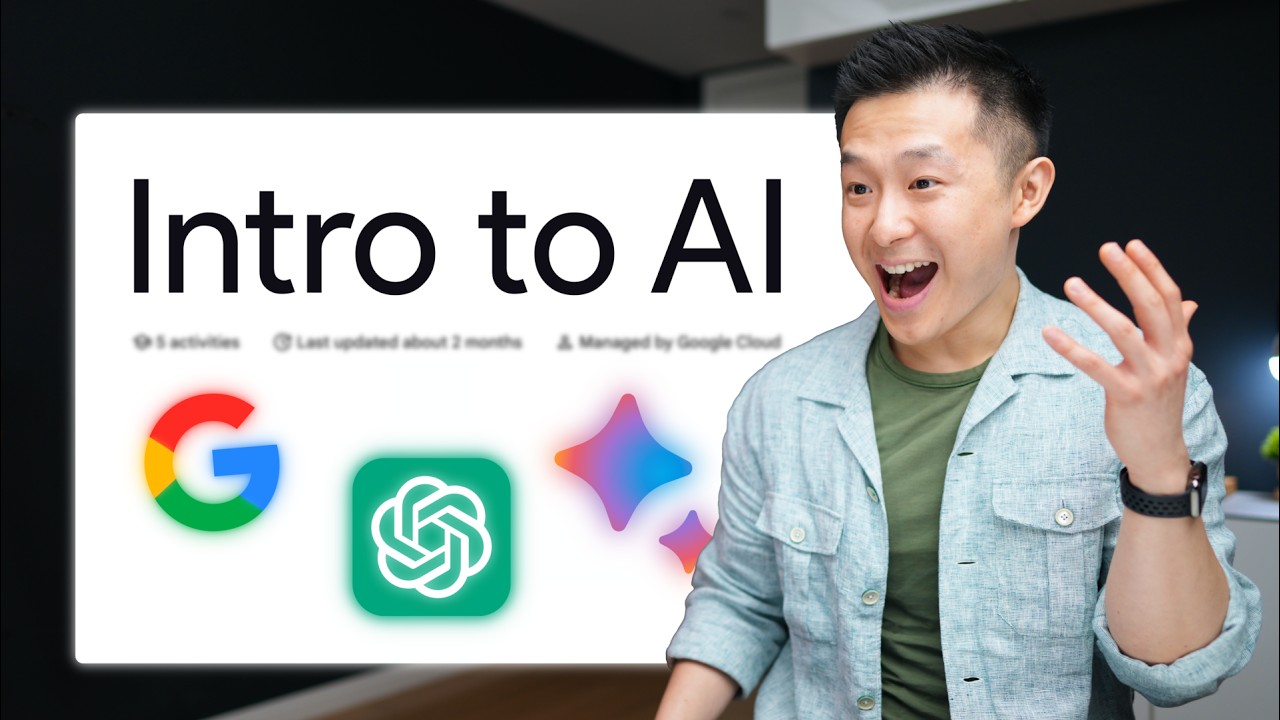If you’re not a tech person but still want to learn some basic AI knowledge, then you should definitely watch this video, because I’ve condensed the content of a 4-hour Google AI literacy course into this 10-minute video. Actually, I didn’t have high expectations for this course at first, because I felt it mainly focused on conceptual things, while our channel doesn’t talk about abstract concepts. Based on my understanding of Google, this course will likely be taken down in an hour. Moreover, I was surprised to find that the underlying conceptual knowledge taught in this course enabled me to better utilize tools like ChatGPT and Google Bard, and also helped me clear up a series of misconceptions about AI machine learning and large language models that I was unaware of. Let’s start with the broadest question: What is artificial intelligence?
I can only admit, with great embarrassment, that I realized I didn’t know the answer before either.
Artificial intelligence, like physics, is an entire field of research. Machine learning is a subfield of artificial intelligence, just as thermodynamics is a subfield of physics. Moving down another level, we come to deep learning, a subfield of machine learning. Deep learning models can be further divided into discriminative models, generative models, and large language models, namely LLMs.
The technology behind familiar applications like ChatGPT and Google Bard also falls under deep learning, and lies at the intersection of LLM and generative AI. Feel free to leave a comment and let me know if you knew about this before. Now that we have a basic understanding of the field and the relationships between different disciplines, let’s take a look at some key points at each discipline level. In general, machine learning is a process of training a model using input data. The trained model can then make predictions based on entirely new data.
For example, if you use Nike sales data to train a model, that model can then predict the sales performance of new Adidas shoes based on Adidas sales data. The two most common types of machine learning models are supervised learning and unsupervised learning.
The key difference between the two is that supervised learning uses labeled data, while unsupervised learning uses unlabeled data. In this example of supervised learning, the scatter plot shows the relationship between the total amount of a single restaurant bill and the amount of tip. Moreover, this data is labeled.
Blue dots represent customer self-pickup orders, while yellow dots represent merchant delivery orders. By using a supervised learning model in this way, we can predict how much tip we will receive next time based on the total bill amount and whether the order is self-pickup or delivery . For unsupervised learning, we would look at whether the original data can automatically form groups. For example, this graph shows the relationship between the number of years an employee has worked in a company and their salary.
We will see that this group of employees has a higher salary/years ratio than the group below.
We also know that this data is unlabeled. If this data is labeled, we would see gender, years of service, department, and so on. We can now use this unsupervised learning model to solve problems such as whether a newly hired employee is growing rapidly. If they are in the group on the left, the answer is yes. If it’s on the right, then no.
In terms of professional skills, there is another significant difference between the two models. After making a prediction, a supervised learning model compares the prediction with the data used to train the model.
If there is a difference between the two, it will try to narrow that difference, while unsupervised learning models will not do so. By the way, this video is unsponsored, but you can support me by subscribing to my Google software tips articles. You can visit my website jeffsu.
org/productivity-ping for more details. After gaining a basic understanding of machine learning, we can begin to learn about deep learning. Deep learning is actually a type of machine learning that uses artificial neural networks for learning. Don’t worry, all you need to know is that artificial neural networks are inspired by the human brain, and they look something like this, with layers of nodes and neurons. The more nodes and neurons a model has, the more powerful it is.
Because of the existence of these neural networks, we can perform semi-supervised learning, which involves training a deep learning model using a small portion of labeled data and a large portion of unlabeled data .
For example, a bank might use deep learning models to detect fraudulent activities. The bank will take some time to label 5% of the transactions as fraudulent or non-fraudulent. Because banks do not have enough time and resources to label all the data, the remaining 95% of transaction data is unlabeled. The secret of this model lies in its use of the 5% of labeled data to learn the basic concepts involved in a task— what are good, what are bad, and what’s good.
This model applies the knowledge learned earlier to the remaining 95% of the unlabeled data, using this entire new dataset to make predictions about future transactions. That’s cool, but it’s not over yet. Deep learning has two types of models: discriminative models and generative models. The discriminant model learns the relationships between the labels in the data, but it can only classify these data points, such as whether they are fraudulent or not. For example, you now have a bunch of images or data points.
Now you label them as dogs or cats. The discriminative model learns the labels for cats or dogs.
If you submit a picture of a dog, it will predict the label for that data point as: a dog. Now we finally get to generative AI. Unlike discriminative models, generative AI models learn patterns in data.
After receiving some input, such as a text instruction, they will generate new content based on the patterns they have just learned . Let’s take the animals from earlier as an example again. These images or data points are not labeled as cats or dogs. The generative model will look for patterns. Oh, these data all contain two ears, four legs, one tail, love to eat dog food, and can bark.
When you ask it to generate something called a dog, the generative model will generate a completely new image based on the rules it has learned. There is a simple way to easily identify whether a model is generative AI. If the output is a number, a category (such as spam or non-spam), or a probability, it is not generative AI.
It is generative AI only when it generates natural language (text or speech), images, or sounds. Generative AI generates entirely new samples, similar to the data used to train it.
Next, let’s talk about different types of generative AI models. Most of us are familiar with text-to-image models such as ChatGPT or Google Bard. Other common model categories include text-to-image models such as Midjourney, DALL·E, and stable diffusion. They can not only generate images, but also edit them.
Text-to-video models—who would have thought?
—can generate and edit videos. For example, there’s imagen video, CogVideo, and the very creatively named make a video. Text-to-3D models can be used to create game assets; a lesser-known example is OpenAI’s shap-e model. Finally, the text-to-task model is trained to perform a specific task. For example, when you type ” @Gmail Please summarize my unread emails”, Bard will read through your inbox and summarize the content of your unread emails.
Next, let’s talk about large language models. Don’t forget that LLMs are also a subset of deep learning. Although there is some overlap, LLMs and generative models are not the same thing. One important difference between the two is that large language models are usually pre-trained with a large amount of data and then fine-tuned according to the specific purpose. What does this mean?
If you have a pet dog, you can train it to learn some basic commands in advance, such as sit, come, lie down, and stay still.
Once it learns, it becomes a well-behaved dog and a generalist. But if this well-behaved dog is to become a police dog, guide dog, or hunting dog, it will need to undergo more specific training to be fine-tuned into that particular specialist dog. The same applies to large language models. They are first trained to perform basic language processing skills, such as classifying text, answering questions, summarizing documents, and generating text.
Then, these large language models are fine-tuned into industry experts using smaller industry datasets to solve specific industry problems, such as in retail, finance, healthcare, and entertainment. In the real world, this could mean that large language models pre-trained by some big tech companies are being fine-tuned by hospitals using their own firsthand medical data, thereby improving the diagnostic accuracy of X-rays or other tests . This is a win-win situation because large companies spend billions of dollars to build a universal model, or a large language model, and then sell these models to smaller institutions, such as retail, banking, and hospitals.
Although they have professional industry data to fine-tune their models, they lack sufficient resources to build their own large language models. For professional skills, if you want to learn this free course, you can go to cloudskillsboost.
google/course_templates/536. If you want to take notes, you can right-click on the video and copy the video URL at the current time, which will allow you to quickly find that video segment. This course has 5 modules. You will receive a small badge for each module you complete. Since this course is quite theoretical, you should definitely watch my videos on how to master AI prompting skills.
See you in the next video! Have a wonderful day!.


Leave a Reply